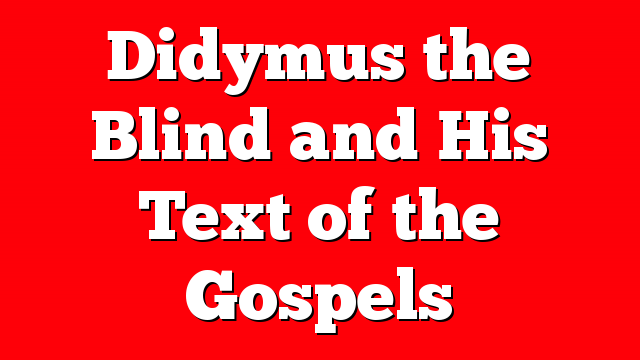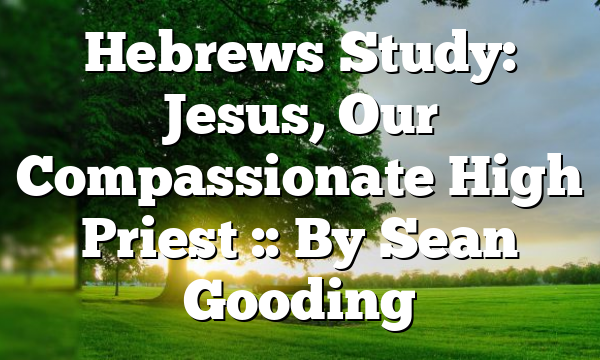Click to join the conversation with over 500,000 Pentecostal believers and scholars
| PentecostalTheology.com
Here are some findings about the Gospels-text of Didymus the Blind, based mainly on Bart Ehrman’s volume in the NTGF (New Testament in the Greek Fathers) series, Didymus the Blind and the Text of the Gospels, published in 1986. Dr. Ehrman went through a lot of effort, in the preparation for his Ph.D. thesis, to collect and analyze the Gospels-quotation in the extant writings of Didymus, who worked in Alexandria in the late 300’s. Even though Ehrman’s work has some flaws, it pursues a worthwhile goal. Let’s try to use it to answer a simple question: was Didymus’ Gospels-text more like Codex Vaticanus (the flagship-manuscript of the Alexandrian Text) or like the Robinson-Pierpont compilation of the Byzantine Text? Book-by-book, let’s sift through the data and find out. (“B” = CodexVaticanus and “Byz” = the Robinson-Pierpont Byzantine Textform, 2005 edition.)
In Matthew, Didymus agrees with either B or Byz (but not both) 49 times.
Didymus agrees with B against Byz 24 times (49%).
Didymus agrees with Byz against B 25 times (51%).
Didymus agrees with Byz against B 25 times (51%).
In Mark – well, in Mark, the data is too sparse to justify confidence that it reflects the affinities of Didymus’ text. Nevertheless: Didymus agrees with either B or Byz (but not both) five times. However, in three cases where Ehrman concludes that Didymus supports a reading in B, the grounds seem especially questionable. Granting every one of them, though:
Didymus agrees with B against Byz 4 times (80%).
Didymus agrees with Byz against B 1 time (20%).
In Luke, Didymus agrees with either B or Byz (but not both) 45 times.
Didymus agrees with B against Byz 28 times (62%)
Didymus agrees with Byz against B 17 times (38%).
In John, Didymus agrees with either B or Byz (but not both) 40 times.
Didymus agrees with Byz against B 23 times (57.5%).
Didymus agrees with B against Byz 17 times (42.5%).
So let’s see here: figuring that nothing comes close to representing the Alexandrian Text of the Gospels as well as Codex B, and that nothing represents the Byzantine Text as well as the RP-2005 compilation – and assuming that the Gospels-utilizations in the extant writings of Didymus the Blind accurately represent the texts he actually used, and assuming that De Trinitate was not written by Didymus the Blind (because that would obviously affect the statistics quite a bit) – did the Gospels-text used by Didymus resemble the Alexandrian Text, or the Byzantine Text?
Didymus agrees with B against Byz 24 times in Mt., 4 times in Mk., 28 times in Luke, and 23 times in John, which equals a total of 79 agreements with B against Byz.
Didymus agrees with Byz against B 25 times in Mt., 1 time in Mk., 17 times in Luke, and 17 times in John, which equals a total of 60 agreements with Byz against B.
Thus, out of 139 places in the Gospels-text used by Didymus where the text is either Alexandrian or Byzantine (but not both), Didymus’ text was Alexandrian 79 times (57%) and Byzantine 60 times (43%).
Normally we would call that a Mixed Text. Didymus’ Gospels-text – particularly in Matthew, where Didymus’ text had a couple more Byzantine readings than Alexandrian readings – was very far from a pure Alexandrian Text. Didymus’ Gospels-text should be called Mixed Alexandrian-Byzantine. Instead, Ehrman calls it the Secondary Alexandrian Text, which conveniently avoids acknowledgement of the very influential presence of the Byzantine Text in the ancestry of the text used by Didymus in Egypt in the late 300’s.
Student might possibly get the impression that when someone says that Didymus used a “Secondary Alexandrian” text, what is meant is that Didymus used a text which was essentially Alexandrian, with some slight secondary alterations. To use the term “Secondary Alexandrian” is to risk giving students and readers such a false impression, accenting the slight Alexandrian majority and pushing the strong Byzantine influence out of the spotlight. A text which favors Byzantine readings in 4 out of 10 variant-units where B and Byz disagree should be called Mixed Alexandrian-Byzantine.



Varnel Watson
all right Philip Williams here you have it 🙂
Philip Williams
Why wouldn’t he be using the Alexandrian text created by Origen in the third century and owing to him, given wide circulation in Alexandria and places influenced by the Alexandrian school?
Now, two major text traditions are circulating, but the Byzantine and the Western churches are going to remain faithful to the traditional text, the same one used by the second century fathers until the liberals discover in the Alexandrian text support for the priority of Mark, key to denying the virgin birth and claims that the resurrection was a product of church theology.
Philip Williams
Why wouldn’t he be using the Alexandrian text created by Origen in the third century and owing to him, given wide circulation in Alexandria and places influenced by the Alexandrian school?
Now, two major text traditions are circulating, but the Byzantine and the Western churches are going to remain faithful to the traditional text, the same one used by the second century fathers until the liberals discover in the Alexandrian text support for the priority of Mark, key to denying the virgin birth and claims that the resurrection was a product of church theology.
Varnel Watson
Philip Williams it is the mystery of the ages And maybe he wasnt even blind They called him so for obviously missing things in the text – I did several projects on his writings back in seminary 🙂